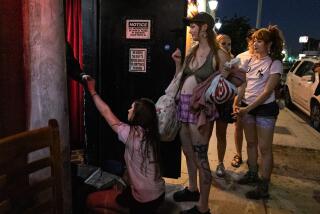Ban Brings Hardship on Mumbai Dancers
MUMBAI, India — Pasties and a G-string are no good to an Indian erotic dancer. With sari firmly tied, she just flashes some navel, or bares her back, to fire up a bar full of men into a money-throwing frenzy.
Striptease is out of the question, table dancing an unimagined horror of Western promiscuity. Women who entertain men in India’s nightclubs are supposed to do so more or less fully clothed, with a vague nod to an ancient art of suggestion.
Nonetheless, here in the country’s business and entertainment capital, the government decided that the stripless tease was evidence of a moral slide that had to stop. It banned nightclub dancers, known as bar girls, in August, claiming they were vulgar and not averse to selling themselves.
Critics say the ban has driven the young women, many of them born into a caste that once produced entertainers for tribal leaders, into much lower-paying jobs. Others have been forced to turn to prostitution in Mumbai’s red-light districts, fetid warrens of rat-infested brothels that are the center of India’s AIDS epidemic.
“The girls are very vulnerable now,” said Varsha Kale, who is fighting the ban as head of the Womanist Party of India. “Pimps are selling the bar girls to other countries because they don’t have any work.”
Nonsense, says Sanjay Aparanti, a deputy police commissioner in Mumbai, formerly known as Bombay.
Before the ban, almost all of the city’s hundreds of dance bars were fronts for prostitution and human trafficking, he contended.
“The dance, per se, is not pernicious,” Aparanti said. “But it’s the dance in that particular place, where liquor is served and clients are sitting getting boozed. Then the whole atmosphere becomes conducive for men to tease girls, or to book girls for further prostitution.
“Hence, we thought that this is the kind of a place where the woman’s dignity is at stake. Under the garb of these dance bars, full-blown trafficking was going on.”
Mumbai’s dance bar owners are fighting the ban in Maharashtra state’s High Court, arguing that the government is infringing on the dancers’ constitutional right to earn a living. A ruling is expected soon.
Kale said the ban threatened the livelihood of about 75,000 women who worked as dancers and waitresses, as well as the families they supported.
It doesn’t affect the more than 100,000 prostitutes who police say are working out of five-star hotels and ramshackle brothels in this city of more than 16 million.
Many bar girls were forced to become dancers because they belong to the Beria caste, whose girls were traditionally selected to become dancers, Kale said. Courtesans used to perform classical dance, in sessions called mujras, for royalty, tribal leaders and the upper class, but in modern times many of the women have ended up in bars, entertaining drunks who shower them with tips.
Indian governments have long tried to end the caste system, which divides millions of people into hundreds of sub-castes, but it remains a powerful source of discrimination.
Pinky Yadav, a member of the Beria caste, was a mujra dancer but quit 15 years ago because, she said, “I found a good man.”
Now Yadav heads what she calls an association of 2,000 dancers. Dozens of them are her tenants.
At the end of an alley, where a man selling balloons on sticks edges past a pile of rotten trash, a rickety set of rusting metal stairs leads to Yadav’s place on the second floor. It’s called Congress House.
On a recent afternoon, 10 young women were sitting barefoot on a black marble floor in long kaftans, mesmerized by a TV soap opera. Their freshly washed hair lifted in a humid breeze stirred by an old ceiling fan. Several had cellphones charging on a small shelf.
When the soap ended, they sat in a circle, overnight cases open on their laps, putting on makeup and laughing like schoolgirls on a sleepover. Then they changed into glittering saris of red, yellow and blue, and headed off to work in the bars where they once danced.
After the ban was imposed last summer, some of the women were kept on as waitresses, but their incomes dropped sharply, Yadav said. As dancers, the bar girls could count on making $10 to $20 a night, a good wage for mostly illiterate young women. Now they’re lucky to bring home a couple of dollars after each shift.
From that, they pay Yadav $34 a month in rent for their bit of sleeping space on the floor or in a cramped loft. That leaves little to send back to families, many of whom have no other income.
Pressure is building on the women to move into Mumbai’s brothels -- hellholes of prostitution and human trafficking that the dance bar ban was supposed to stop, Yadav said.
“They’re in a very bad position,” said Yadav, her arm draped over a knee as she sat on the floor of a tiny bedroom. “Three or four of my friends’ children were studying at good boarding schools.
“After the ban, they had to pull the children out. They can’t pay the fees.”
Shweta Sharma, 21, was born into the same caste as Yadav, and for more than two years she has supported her mother and five other family members.
She doesn’t have the hard-edged stare of prostitutes her age who wait for customers in Kamathipura, one of Mumbai’s largest red-light districts, where four-story brothels stand next to tailor shops, dry cleaners and a clinic specializing in ailments of the “Skin, V.D. and Sex.”
Sharma is cryptic about what she will do if she loses her bar job, or if the money runs out.
“I don’t know what I’ll do,” she said. “Whatever I haven’t done until now, I’ll have to do that someday.”
Sharma still works in the Hino Bar where she once danced, but she’s a waitress now. More than 50 others were fired after the ban. A hundred men used to pack the small bar on any given night, but on a recent Monday only one sat with a cold beer on the glass table at his knees.
He sat grinning while four women stood a few feet in front of him, trying not to move too much to the beat of Bollywood tunes blaring from the sound system.
All but one of the women wore colorful saris that wouldn’t have looked out of place at a respectable party. The other wore tight blue jeans and a red top, and swayed her hips, ever so slightly, in what might be construed as dancing.
Trying to draw the lone customer’s eye, a woman in a bright yellow sari adjusted her sleeve to expose the curve of her shoulder. After a few songs, the women sat in a corner and a new group formed a line, batting their eyelashes and smiling for the man, trying to coax a tip out of him.
One of the politicians who led the campaign against bar dancing is Vivek Patil, a member of the state assembly from the Peasants and Workers Party.
His district in the city of Panvel, a rail and highway crossroads outside Mumbai, had become a hub for prostitution run out of dance bars, he said.
“These ladies’ bars had become a big problem [for the community], especially for the younger generation, because instead of working, they were going and spending time in these bars,” he said.
“If they didn’t have enough money, they would resort to anything to acquire it. There have been cases where youths have murdered their own mothers for the sake of going to these dance bars.”
But there’s no need to go overboard against prostitution and close Mumbai’s red-light districts, Patil said. He thinks every city needs some place where men can go to buy sex even though prostitution is illegal across India.
“If societies didn’t have these red-light areas, rapes would go up,” the lawmaker reasoned.
Bar owners in Mumbai contended that their dancers provided clean entertainment for the middle classes in what has long been one of India’s most cosmopolitan cities.
“Several members of the legislative assembly used to come here,” said a co-owner of Hino Bar. “They weren’t regulars, just twice a week.” He asked not to be identified because he feared pressure from police.
Strictly for research, police official Aparanti visited a strip club during a trip to New York. After seeing stark naked women strutting on a catwalk, he said, he was certain that Indian men couldn’t be trusted to resist even the more subtle temptations of dancers in saris.
“The Indian man does not have the opportunity to mingle with females,” he said. “If he has not gone to college, the only woman in his life -- apart from his daughter, sister or mother -- is his wife. So this man is vulnerable.
“In Las Vegas, what an Indian man would do ... ,” and the very thought left Aparanti searching for words. “You would have to tie him down.”
Kale says that arguments against the bar girls are exaggerated and that sexist, upper-caste men want the dance bars closed because they can’t stomach a low-caste woman making a good, clean living.
“This is a male-dominated society,” she said. “The fact that a girl is earning [$560] a month from dancing is something that the males cannot tolerate.
“If they sleep with a man and earn $11, then the males can pity them as sex workers who have to sell themselves for a pittance to earn their living. A girl from a nomadic tribe earning [$560] from dancing is not acceptable to this society of ours.”
More to Read
Sign up for Essential California
The most important California stories and recommendations in your inbox every morning.
You may occasionally receive promotional content from the Los Angeles Times.










